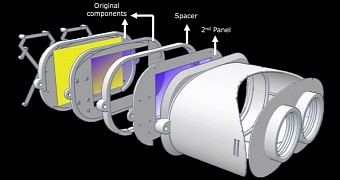According to recent studies by Stanford researchers, it seems that VR headsets can actually cure nausea and, paradoxically, eye fatigue.
Although the relationship between the human eye and any form of frequency-based displays has not been traditionally a good one, it appears that, thanks to next-generation VR prototype headsets, this issue is gone.
Usually, when people try VR headsets, headaches and weird gut feelings happen pretty fast, generally because of the novelty of such prototype devices and the lack of refinement ergonomically-wise, given the simple LCD displays emitting light close to the eyes.
However, with help from NVIDIA, Stanford has managed to develop a more eye-friendly, health-aware headset device that will not only stop from being a health issue when worn by users but could actually cure eventual migraines or nausea.
It appears that the depth of field is also enhanced, as in the current generation of headsets, the eye is forced to focus on a single place. To enhance this issue on the new headsets, the researchers decided to help the eye perceive different perspectives of the same 3D scene at different positions of the pupil, helping the wearer focus on different depths.
Improving VR display technology from scratch
The new technology that enables such advanced 3D stereoscopy is called Light-field Stereoscope Technology, and it wants to cure the mismatch between the cues of what you see and what you feel when seeing and acting inside a virtual space, while your inner ear does not have the same physical feedback.
To fix this disconnect, Prof. Gordon Wetzstein, assistant professor in electrical engineering at Stanford, created a sort of hologram for each eye to make the experience seem more natural. A light field creates multiple, slightly different perspectives over different parts of the same pupil, with the result of freely moving your focus and introducing depth in the virtual scene, just like in real life.
In Wetzstein's words, "You have a virtual window which ideally looks the same as the real world, whereas today you basically have a 2D screen in front of your eye."
The headset design incorporates two stacked, transparent LCD displays with a space in between and is just a stop-gap version, with off-the-shelf parts, being a step towards a final more refined version.
The new device will be presented together with NVIDIA at SIGGRAPH on August 9 to 13.

 14 DAY TRIAL //
14 DAY TRIAL // 